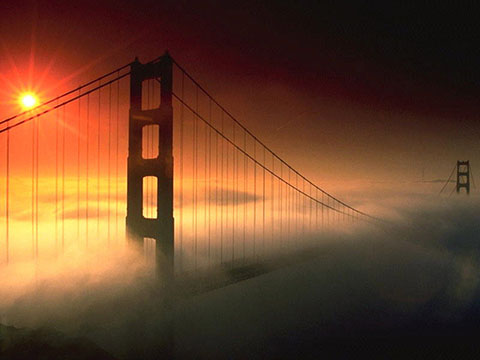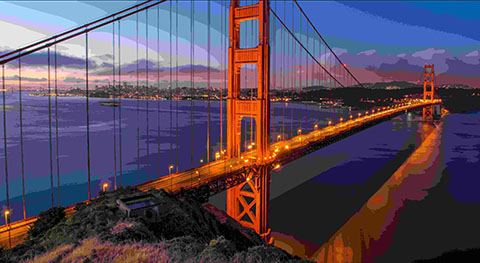 The Golden Gate Bridge is a suspension bridge spanning the Golden Gate strait, the mile-wide, three-mile-long channel between San Francisco Bay and the Pacific Ocean. The structure links the U.S. city of San Francisco, on the northern tip of the San Francisco Peninsula, to Marin County, bridging both U.S. Route 101 and California State Route 1 across the strait. The bridge is one of the most internationally recognized symbols of San Francisco, California, and the United States. It has been declared one of the Wonders of the Modern World by the American Society of Civil Engineers.
The Golden Gate Bridge is a suspension bridge spanning the Golden Gate strait, the mile-wide, three-mile-long channel between San Francisco Bay and the Pacific Ocean. The structure links the U.S. city of San Francisco, on the northern tip of the San Francisco Peninsula, to Marin County, bridging both U.S. Route 101 and California State Route 1 across the strait. The bridge is one of the most internationally recognized symbols of San Francisco, California, and the United States. It has been declared one of the Wonders of the Modern World by the American Society of Civil Engineers.
The Frommers travel guide considers the Golden Gate Bridge “possibly the most beautiful, certainly the most photographed, bridge in the world”. It opened in 1937 and had, until 1964, the longest suspension bridge main span in the world, at 4,200 feet.
The Golden Gate Bridge officially opened on May, 1937, by President Franklin D. Roosevelt in Washington, D.C.

Until 1964, the Golden Gate Bridge had the longest suspension bridge main span in the world, at 4,200 feet (1,300 m). Since 1964 its main span length has been surpassed by ten bridges; it now has the second-longest main span in the United States, after the Verrazano-Narrows Bridge in New York City.
Total length of the Golden Gate Bridge from abutment to abutment is 8,981 feet. The Golden Gate Bridge’s clearance above high water averages 220 feet while its towers, at 746 feet above the water, were the world’s tallest on a suspension bridge until 1998 when bridges in Denmark and Japan were completed.
The weight of the roadway is hung from two cables that pass through the two main towers and are fixed in concrete at each end. Each cable is made of 27,572 strands of wire. There are 80,000 miles of wire in the main cables. The bridge has approximately 1,200,000 total rivets.